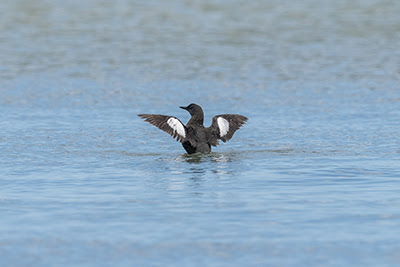Windy weather over the Christmas period wasn't exactly conducive to doing any mist netting in the garden and to be honest the mild weather meant there aren't many birds around - so far this winter period I've see none Redpoll in the garden and have yet to see a Siskin! A few days cold frosty weather brought an influx of Blackbirds into the garden and most days there were at least 6-8 feeding on spilt seed beneath the feeders. With the possibility these were continental immigrants I decided to try and catch a few and used walk in traps baited with cheese. I caught 8 in a 3 day period. To put this into perspective this equals the total for the best year since I've been ringing in the garden. I generally catch between 2 -4 per year!
Although I can't prove they were continental birds the long wing length and heavy weight suggests they were. As soon as the cold snap finished they were gone.
One day was calm enough to try and mist net but the Blackbirds avoided the nets. I was surprised to catch this beauty though as I hadn't even seen one in the garden or heard one in the nearby trees!
A 1st winter male Nuthatch aged by the general feather wear and a slight moult contrast in the lesser coverts.
Although we've no Redpolls or Siskins there are plenty of Goldfinches including this 1st winter Goldfinch showing a distinct moult contrast in the greater coverts with the outer ones being duller and buff tipped in contrast to the newer adult type inner ones.
Since I started ringing in the garden in 2014 the number of birds caught annually has increased along with the number of species. This could be due to a genuine increase in numbers as I've started feeding far more intensively or due to increased ringing activities (although I think my efforts have been fairly consistent. I'm going to analyse the data further to see if, for example, there's an increased recapture rate, suggesting feeding has improved survival rates.
The graph below shows number of birds and number of species plotted against year.
As would be expected Blue Tits are by far the commonest species ringed with Great Tit in 2nd place. Whats surprising is Goldfinch in 3rd place with Greenfinch in 4th. Given the Greenfinch has been hit badly by trichomonosis nationally this is a good sign.
8 Jan 2015
Subscribe to:
Post Comments
(
Atom
)
































































No comments :
Post a Comment